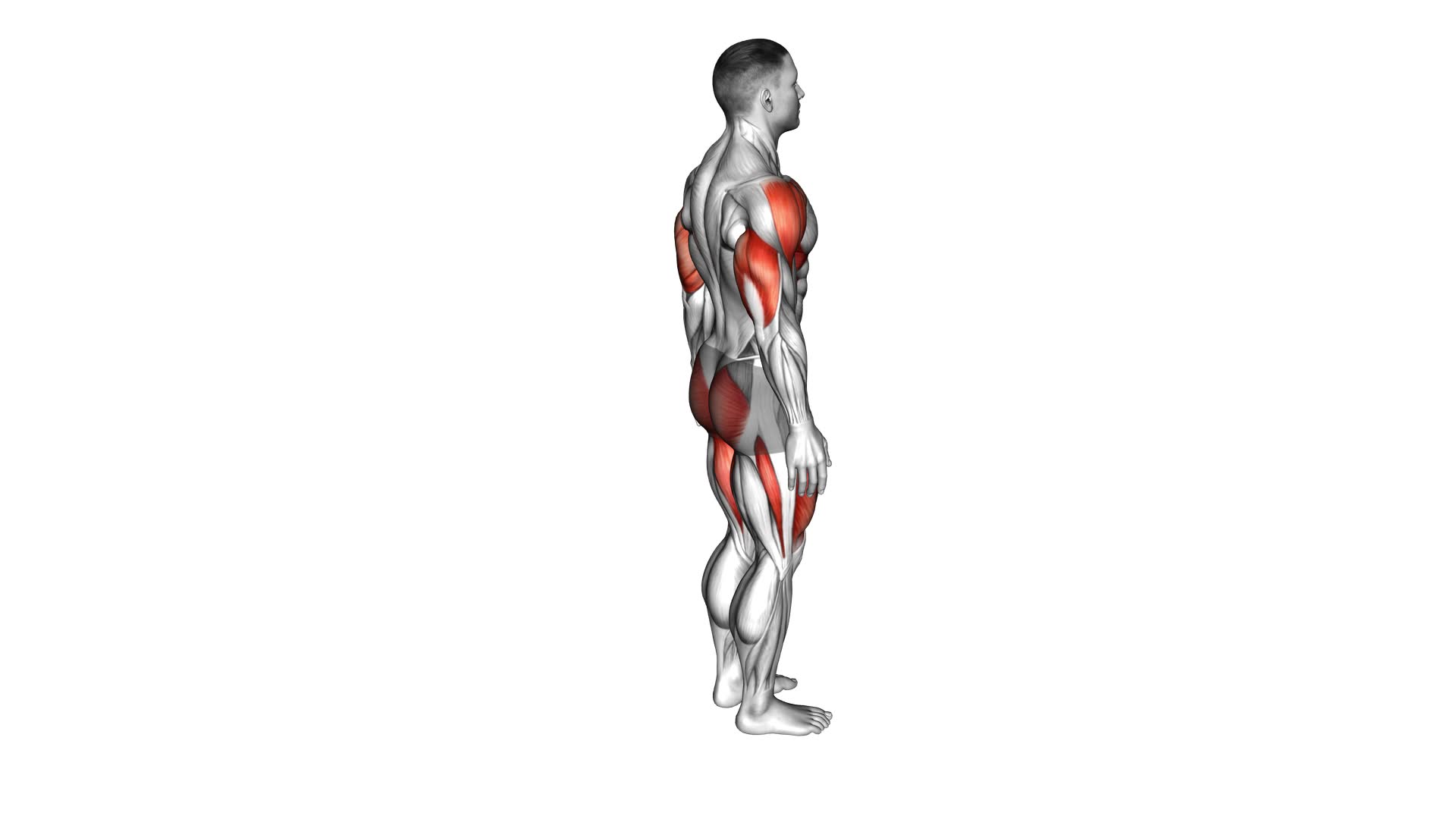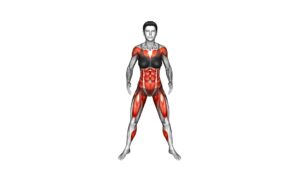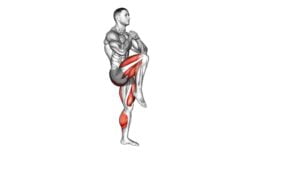Bodyweight Reverse Lunge With Overhead Reach (Male) – Video Exercise Guide & Tips

Looking to add a challenging twist to your workout routine? Try the bodyweight reverse lunge with overhead reach!
Watch This Exercise Video
This exercise targets your lower body while also engaging your core and upper body muscles.
In this video exercise guide, you'll learn the proper form and technique for male reverse lunges, as well as an overhead reach variation for increased difficulty.
Incorporate these reverse lunges into your routine for a full-body workout that will leave you feeling stronger and more balanced.
Key Takeaways
- Bodyweight reverse lunges target lower body muscles including quadriceps, hamstrings, glutes, and calves.
- Proper form and technique for male reverse lunges include starting with feet hip-width apart, stepping back with one foot, lowering the body by bending both knees, keeping the torso upright and engaging the core for stability, and pushing through the front heel to return to the starting position.
- Common mistakes to avoid when performing reverse lunges include allowing the front knee to extend past the toes, leaning too far forward, maintaining proper alignment of the front knee and ankle, maintaining upright posture and engaging the core for stability, and focusing on engaging the correct muscles.
- Adding an overhead reach variation to reverse lunges increases difficulty by engaging more muscles, improving balance and stability, and increasing the range of motion in the upper body.
Benefits of Bodyweight Reverse Lunges
Experience the numerous benefits of bodyweight reverse lunges, including increased lower body strength and improved balance. Bodyweight reverse lunges are a highly effective exercise that targets your quadriceps, hamstrings, glutes, and calves. By performing this exercise regularly, you can enhance the strength and stability of your lower body muscles.
One of the key benefits of bodyweight reverse lunges is the increased lower body strength they provide. As you lunge backward, your front leg works to push your bodyweight back up, engaging your quadriceps and glutes. This constant resistance helps to build strength in these muscle groups, leading to improved overall lower body strength.
Additionally, bodyweight reverse lunges are great for improving balance. This exercise requires you to stabilize your body as you move backward and lower down into the lunge position. By practicing this movement, you can enhance your proprioception and coordination, leading to better balance in your daily activities.
To further increase the difficulty of bodyweight reverse lunges, you can incorporate variations such as adding weights, performing jump lunges, or adding a knee drive at the top of the lunge. These variations challenge your muscles in different ways, providing additional benefits and helping you progress in your fitness journey.
Now that you understand the benefits of bodyweight reverse lunges, let's move on to the next section, where we'll discuss the proper form and technique for male reverse lunges.
Proper Form and Technique for Male Reverse Lunges
To perform proper form and technique for male reverse lunges, start by standing with your feet hip-width apart. Take a step back with your right foot, landing on the ball of your foot. Lower your body by bending both knees until your left thigh is parallel to the ground, ensuring that your right knee hovers just above the floor. Keep your torso upright and engage your core for stability. Push through your left heel to return to the starting position. Repeat on the other side by stepping back with your left foot.
When performing male reverse lunges, it's important to avoid common mistakes. One common mistake is allowing your front knee to extend past your toes, which can put unnecessary strain on the knee joint. To prevent this, focus on keeping your front knee aligned with your ankle throughout the movement. Another mistake is leaning too far forward, which can compromise your balance and engage the wrong muscles. Instead, maintain an upright posture and engage your core to stabilize your body.
There are several benefits to incorporating reverse lunges into your workout routine. They target the glutes, quadriceps, and hamstrings, helping to strengthen and tone the lower body. Reverse lunges also improve balance and stability, as they require coordination and control. Additionally, they can be modified to increase or decrease the intensity, making them suitable for individuals of all fitness levels.
Overhead Reach Variation for Increased Difficulty
To increase the difficulty of the bodyweight reverse lunge, incorporate the overhead reach variation. This advanced lunge modification adds an extra challenge to your workout routine and targets your core, shoulders, and upper back.
Here's how to perform the overhead reach modification:
- Start by standing with your feet shoulder-width apart and your arms extended overhead.
- As you step back into the reverse lunge, lower your arms down to shoulder level.
- As you push through the front heel to return to the starting position, reach your arms back up overhead.
By incorporating the overhead reach modification, you engage more muscles and improve your balance and stability. This variation also increases the range of motion in your upper body, promoting flexibility and mobility. Remember to maintain proper form throughout the exercise, keeping your core engaged and your chest lifted.
Now that you understand the overhead reach variation, you can incorporate it into your reverse lunge routine for an added challenge. This modification will help you take your workout to the next level and achieve your fitness goals.
Tips for Incorporating Reverse Lunges Into Your Workout Routine
To maximize the effectiveness of your workout routine, incorporate reverse lunges with overhead reach into your exercise regimen. Reverse lunges are a great way to target your lower body muscles, including your glutes, hamstrings, and quadriceps. Adding an overhead reach to the movement increases the challenge, engaging your core and upper body as well.
One way to make reverse lunges even more challenging is by incorporating weights. Holding dumbbells or a barbell on your shoulders will add resistance and increase the intensity of the exercise. Start with lighter weights and gradually increase as you become more comfortable and stronger.
If you're new to reverse lunges or have any knee issues, you can modify the exercise to make it more accessible. Instead of stepping back into a lunge, try stepping forward into a reverse lunge. This places less stress on the knees and is a great option for beginners or those with knee discomfort.
Remember to maintain proper form throughout the exercise. Keep your chest lifted, shoulders back, and core engaged. Take a step back, lowering your back knee towards the ground while keeping your front knee directly above your ankle. Push through your front heel to return to the starting position. Repeat on the other side.
Incorporating reverse lunges with overhead reach into your workout routine will help you build strength, improve balance, and increase overall muscle tone. Start with a few sets of 10-12 reps and gradually increase the number of sets and reps as you progress. Remember to listen to your body and rest as needed.
Happy lunging!
Common Mistakes to Avoid When Performing Reverse Lunges
When performing reverse lunges, it's important to be aware of common mistakes that can hinder your form and effectiveness. Proper alignment and foot placement are crucial for maximizing the benefits of this exercise and reducing the risk of injury.
Here are some common mistakes to avoid:
- Poor alignment: Make sure your front knee is directly above your ankle and your back knee is hovering just above the ground. Avoid leaning too far forward or backward, as this can strain your knees and lower back.
- Incorrect foot placement: Keep your front foot firmly planted on the ground, with your toes pointing forward. Your back foot should be positioned on the ball of your foot, with the heel lifted. Avoid rolling your feet inward or outward, as this can compromise your stability and balance.
- Lack of control: Maintain control throughout the entire movement. Avoid rushing through the exercise and focus on engaging your core and glutes to stabilize your body. This will ensure proper form and increase the effectiveness of the exercise.
Frequently Asked Questions
How Many Calories Can I Expect to Burn by Doing Bodyweight Reverse Lunges?
When you do bodyweight reverse lunges, you can expect to burn calories. The exact number of calories burned will depend on factors such as your weight, intensity, and duration of the exercise.
However, reverse lunges are generally considered a great calorie-burning exercise as they engage multiple muscle groups.
Additionally, if you're looking for knee-friendly modifications, you can try reducing the range of motion or using a support, such as holding onto a chair while performing the exercise.
Can I Do Reverse Lunges if I Have Knee Pain or Knee Injuries?
If you have knee pain or knee injuries, you may want to consider alternative exercises for your leg workouts. Reverse lunges can put strain on the knees, so it's important to modify the exercise to accommodate your condition.
One modification you can try is reducing the range of motion by not going as deep into the lunge. Additionally, you can use a support, like a chair or wall, to assist with balance and stability.
Always listen to your body and consult with a healthcare professional for personalized advice.
Are Reverse Lunges More Effective for Targeting Specific Muscles Compared to Regular Lunges?
Reverse lunges are more effective for targeting specific muscles compared to regular lunges. By stepping back instead of forward, reverse lunges place greater emphasis on the glutes and hamstrings. This helps to strengthen and tone these muscles while also improving balance and stability.
Additionally, the overhead reach in the bodyweight variation of the exercise engages the core and upper body, providing additional benefits. Incorporating reverse lunges into your workout routine can help you achieve better overall muscle development.
How Many Sets and Repetitions Should I Do When Incorporating Reverse Lunges Into My Workout Routine?
When incorporating reverse lunges into your workout routine, it's important to consider the repetition range and the benefits of this exercise.
The ideal repetition range for reverse lunges is around 8-12 repetitions per set. This allows you to focus on building strength and muscle endurance.
Reverse lunges are great for targeting your glutes, quadriceps, and hamstrings while also improving your balance and stability.
Make sure to start with a weight that challenges you but still allows you to maintain proper form.
Can I Use Dumbbells or Other Weights While Performing Reverse Lunges to Increase the Intensity?
Yes, you can definitely use dumbbells or other weights to increase the intensity of your reverse lunges. Adding weights will challenge your muscles more and help you build strength.
However, it's important to start with lighter weights and gradually increase as you get more comfortable.
If you have knee pain or injuries, you can modify the reverse lunge by reducing the range of motion or using a support like a chair or wall to stabilize yourself.
Conclusion
Incorporating bodyweight reverse lunges into your workout routine can provide numerous benefits for men. These include improved lower body strength, stability, and balance. By adding the overhead reach variation, you can increase the difficulty and engage your core muscles even further. Remember to maintain proper form and technique to avoid common mistakes.
With these tips, you can confidently perform reverse lunges and enhance your overall fitness level.

Author
Years ago, the spark of my life’s passion ignited in my mind the moment I stepped into the local gym for the first time. The inaugural bead of perspiration, the initial endeavor, the very first surge of endorphins, and a sense of pride that washed over me post-workout marked the beginning of my deep-seated interest in strength sports, fitness, and sports nutrition. This very curiosity blossomed rapidly into a profound fascination, propelling me to earn a Master’s degree in Physical Education from the Academy of Physical Education in Krakow, followed by a Sports Manager diploma from the Jagiellonian University. My journey of growth led me to gain more specialized qualifications, such as being a certified personal trainer with a focus on sports dietetics, a lifeguard, and an instructor for wellness and corrective gymnastics. Theoretical knowledge paired seamlessly with practical experience, reinforcing my belief that the transformation of individuals under my guidance was also a reflection of my personal growth. This belief holds true even today. Each day, I strive to push the boundaries and explore new realms. These realms gently elevate me to greater heights. The unique combination of passion for my field and the continuous quest for growth fuels my drive to break new ground.







